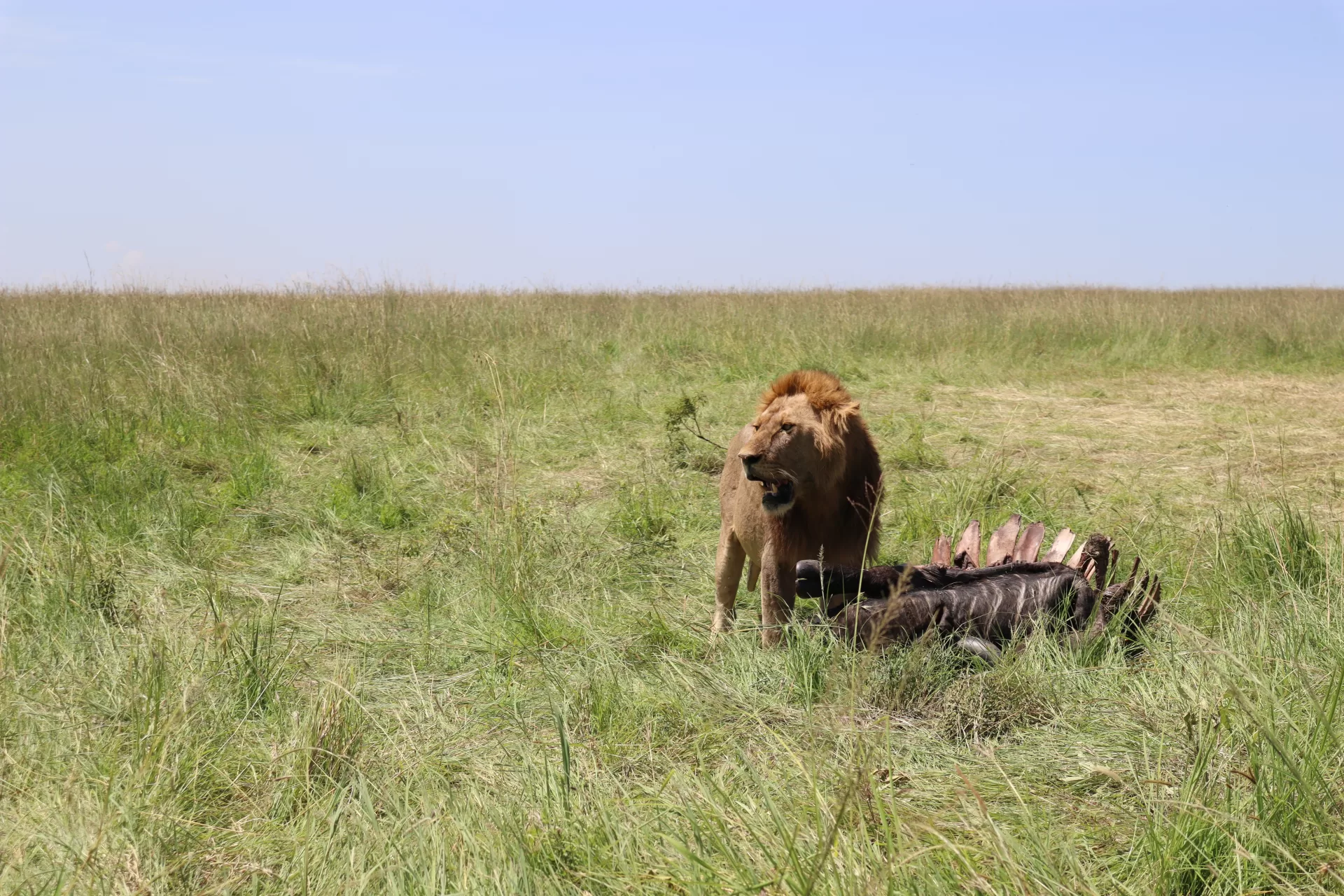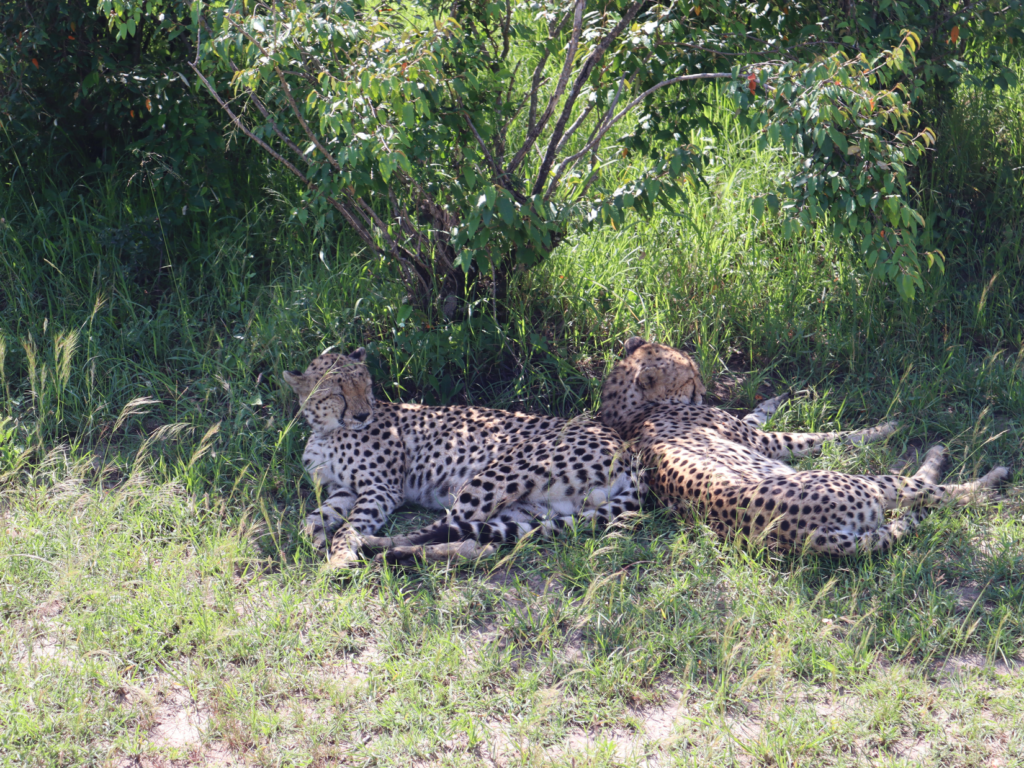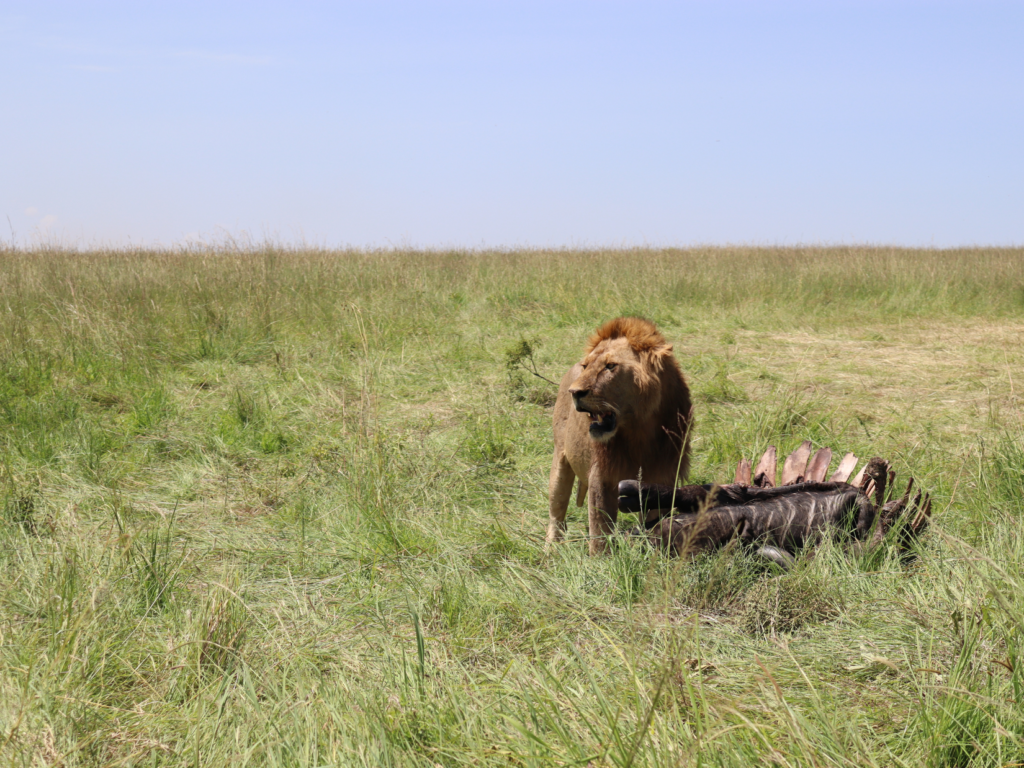Going on a Masai Mara safari in Kenya had always been at the top of my bucket list, and I finally turned that dream into reality.
I went on a 3-day group safari to the Masai Mara National Reserve, and the experience was incredible – far beyond what I had ever imagined. Observing wild animals roaming freely across the savannah, and right next to our vehicle, felt surreal.
So, here I am now, sharing everything you need to know to help you plan your safari adventure. You’ll find out what’s the best time to visit the Maasai Mara Reserve, how to book a safari in Kenya, the best accommodation options, how to get from Nairobi to Masai Mara, and much more.
What to Expect on a Group Safari
Non-private vehicle
When you go on a group safari, you’ll share a vehicle with other travelers, and it can either be a van or a 4WD, depending on your operator. I booked a safari tour with a local operator from Nairobi, and there were 6 of us in a 4WD Land Cruiser. Typically, a 4WD carries up to 8 people, while vans are used for larger groups.
Different accommodations are possible
In terms of accommodation, all tours offer quite a bit of flexibility, so you don’t necessarily have to stay in the same tent or lodge as the other people in your group. You can tailor your experience according to your budget.
Itineraries are fixed
A typical safari day starts early morning, usually around 7 AM, and ends in the evening, lasting about 9 to 11 hours. If there’s a place you want to spend more time at, this may not be possible because you’re part of a group with a pre-planned itinerary.
Although group safaris don’t offer the same flexibility as private ones, a lot depends on your guide. I was lucky enough to get a guide who was very considerate and who made a real effort to ensure that everyone was happy.
What is the Masai Mara Famous for?
Maasai Mara National Reserve, often spelled Masai Mara and locally referred to as “The Mara,” is one of the largest game reserves in Kenya. It stretches 1,510 square kilometers (580 square miles) in area and borders the Serengeti National Park in Tanzania to the south.

One of the highlights of Masai Mara is meeting the Maasai, the semi-nomadic people who inhabit southern Kenya and northern Tanzania. They’re one the most well-known indigenous tribes in Africa, known for their unique culture and tribal dress. During your safari, you’ll have an opportunity to visit a Maasai village, where you can experience their tribal way of life firsthand. You might also see Maasai warriors at your camp, as they often work as guards to keep wildlife away.
But the cultural aspect isn’t the only thing that makes the Masai Mara stand out. It’s also famous for the Great Wildebeest Migration, a spectacular event where over a million wildebeest, along with zebras and gazelles, travel from the Serengeti to the Masai region. This epic journey typically happens from July to October, with August being the best month to catch the migration in full swing.
If you only have a few days for a safari, then Masai Mara game reserve is your best bet. With the highest concentration of wildlife in Kenya, you’ll have a great chance to see a wide variety of animals in a short time. Also, the chances of spotting the Big Five ( lion, leopard, rhinoceros, elephant, and buffalo) are incredibly high, and you can see them year-round, even during the low season.
What is the Best Time to Visit Masai Mara?
As I mentioned earlier, the Annual Great Migration peaks in August, making it the best time of the year to visit Masai Mara if you want to see this natural spectacle. During the migration season, you’ll see large herds of wildebeests, zebras, and gazelles across the savannah plains.
However, if you can’t make it in August, don’t worry – the Masai Mara is a year-round safari destination. The climate is pleasant, with warm days and cooler nights, just right for wildlife viewing throughout the year.
When planning your safari in Kenya, keep in mind the different seasons as prices for safaris can vary accordingly:
- High season: January to March and July to October
- Shoulder season: November to December
- Low season: April to June
The Masai Mara has two rainy seasons: the short rains in November and December, and the long rains from March to May. April usually gets the most rain, and although you might encounter muddy trails, you’ll also experience lush landscapes and fewer crowds.
How to Get to Masai Mara from Nairobi?
The Masai Mara is about 253 km from Nairobi, which typically takes 5 to 6 hours by road, or about 45 minutes to an hour by plane.
Here are a few ways to get to Masai Mara from Nairobi.
By Safari Vehicle:
If you’ve booked a safari package, transfers are typically included. You’ll travel in a safari van or 4×4 Land Cruiser.
By Car
If you haven’t booked a safari tour and prefer to go on your own, driving to the Masai Mara is an option. You’ll need a 4×4 vehicle because the roads inside the park aren’t paved and a regular car won’t be suitable.
There are no signposts inside the Masai Mara, so if you’re not familiar with the area, it’s best to arrange game drives with your lodge or hire a Maasai guide.
By Public Transportation
A budget-friendly way to reach the Masai Mara is by using local public transportation, matatus, or coaches. Here’s how to do it:
Step 1: Nairobi to Narok: Catch a matatu from the Nyama Kima area in Nairobi’s CBD. Make sure to take the first one in the morning since this part of the journey takes about 3.5 to 4 hours, and then you will need to catch a second bus from Narok to Sekani at around midday.
Step 2: Narok to Sekenani (Masai Mara): From Narok, you’ll need to change to another matatu heading to the Sekenani, where Masai Mara begins. Matatus heading towards the park usually stops running around midday or 1 PM, so you should leave Nairobi as early as possible.
Shared Taxi Option: If you miss the matatus, you can still get to the Masai Mara by sharing a taxi with up to four others. The price is roughly the same as the matatu, but like the matatus, taxis only leave when they’re full.
By Plane
If you’re short on time or just want a more convenient way to get to the Masai Mara, flying is probably your best option. It only takes about an hour from Nairobi’s Wilson Airport.
Some safari packages even include flights, which makes things super easy.
How Many Days Do You Need in Masai Mara?
For the best experience, you should stay at least 3 days and 2 nights in the Masai Mara. That’s enough time to see the ‘’Big 5’’ and enjoy the abundant wildlife and stunning scenery without feeling rushed.
If you have a higher budget, you can opt to stay for 4 or 5 full days. With additional days, you’ll have time to explore different areas of the park, go on a cultural tour of Maasai village, and enjoy activities like the Hot Air Balloon Safari. This is probably the most magical way to experience the Masai Mara’s wilderness.
Is There Malaria in Masai Mara?
While malaria is a significant health concern in many parts of Kenya, it’s less common in the Masai Mara due to its high elevation (between 1,486 and 2,149 meters or 4,875 and 7,052 feet). However, malaria still exists, though in low numbers.
To minimize any risk, you should use mosquito repellents that contain DEET and cover up at dusk and dawn when mosquitos are most active.
I personally didn’t take any antimalarial medication during my visit to the Masai Mara, but it’s always best to consult with your doctor. You can decide together whether you want to use malaria prophylaxis before traveling to the area.
What to Pack for a Safari?
When preparing for a safari in Kenya, there are some essentials that you’ll definitely need. Make sure to bring any prescription medication you may require, along with sunglasses, a hat, a mosquito repellent with DEET, and sunblock.
Pack casual and comfortable clothing, and include a warmer jacket for the cooler nights and early mornings.
The Masai mara is a photographer’s paradise, so don’t forget to pack your camera and binoculars to capture and observe the incredible wildlife.
If you’re traveling with a suitcase, you can either leave it with your safari tour operator in Nairobi or use a storage service like Radical Storage, and take only a backpack on the safari itself.
Where to Stay in Masai Mara
There are plenty of accommodation options in and around the Masai Mara, from budget camps to the most luxurious safari lodges.
Inside the Reserve:
Staying inside the park or Mara Triangle offers a more immersive experience but it’s also more expensive. You’ll have to pay daily park fees on top of your accommodation costs, whether you go on safari that day or not.
Outside the Reserve:
If you’re traveling on a budget, you may find more affordable options outside the reserve gates. In this case, you’ll only pay park fees on the days you enter the reserve or Mara Triangle.
Electricity and Power:
When choosing your accommodation, be aware that some camps operate on generator power only and typically turn it off from around 10 pm to 6 am. However, some camps and lodges use solar power, which means you’ll have continuous electricity and lighting throughout the night.
The Best Safari Lodges in Masai Mara
Greenwood Safari Camp – Located right next to the Talek Gate of Masai Mara National Park, this camp is an affordable option, perfect for budget travelers.
Fairmont Mara Safari Club – A luxury stay right on the Mara River, where you can wake up to hippos just outside your private veranda. This high-end camp offers game drives, an outdoor heated pool, and massage tents. It’s just a 10-minute drive from Ngerende Airstrip, accessed by flights from Nairobi Airport.
Sarova Mara Game Camp – Right in the heart of the Maasai Mara, this camp has everything you need, including a pool with a poolside bar. They’ve got their safari vehicles and guides, plus barbecue facilities and entertainment options. The camp is secured with a 24-hour electric fence.
Talek Bush Camp – Set right on the banks of the Talek River where you can watch baboons, hippos, and crocodiles. It’s just a 5-minute drive to Talek Gate, making it super convenient for early morning game drives when the animals are most active. They also offer great game drives and can arrange transfers from the airport.
Fig Tree Camp – This luxury camp is located inside the Maasai Mara National Park, on the banks of the Talek River. It offers a swimming pool and unique experiences like Champagne Bush Dinners under the stars. You can also enjoy night game drives and barbecue dinners on the Mara plains.
Neptune Mara Rianta Luxury Camp – This luxury tented camp offers incredible views of the Mara River, with hippos and crocodiles right outside your terrace. Located in the Mara North Conservancy, you’ll have wildlife like lions, giraffes, and antelope right at your doorstep.
Olare Mara Kempinski – This property offers a full 5-star luxury experience in the heart of the Maasai Mara. Located on the banks of the Ntiakitiak River, it boasts breathtaking views of the savannah and nearby wildlife. It offers deluxe twin-bed tents of 80 sqm and 115 sqm honeymoon suites with a private plunge pool.
Mara Intrepids Tented Camp – This camp offers a beautiful luxury stay in the heart of the Maasai Mara, and features an outdoor pool with sun loungers, a library, and a children’s playground. The tents are stylishly furnished, giving you an ‘Out of Africa’ vibe.
How Much Does a Massai Mara Safari Cost?
The price of a Masai Mara safari depends on many factors such as the season, duration, type of accommodation, and vehicle choice. Budget safaris start from about $200 per day, mid-range safaris cost $350-$600 per day, while luxury safaris can range from $1,500 to $5000 per person per day.
Park Fees:
The entry fees for the Masai Mara have increased, so here are the new prices for non-residents:
- January 1 – June 30, 2024: USD 100 per day for adults, USD 50 per day for children (ages 9-17; children under 8 are free).
- July 1 – December 31, 2024: USD 200 per day for adults, USD 50 per day for children (ages 9-17; children under 8 are free).
If you book a safari with a tour operator, park fees will be typically included, along with accommodation, meals, game drives with a guide, and transportation between Nairobi and the Masai Mara.
How to Book a Safari in Kenya?
You can either book directly with a local tour operator, choose from a range of safari tours available online, or join me on an unforgettable safari adventure.
I hope this guide helps you plan your safari in Masai Mara.
Read Also: Visiting a Maasai Village | Facts About the Maasai Tribe
Read Also: Is Kenya Safe to Visit as a Solo Female Traveler













Leave a reply